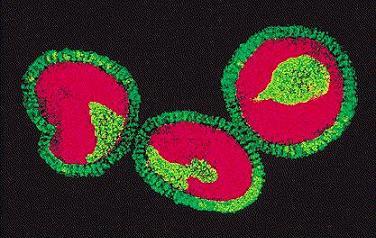Influenza (“flu”) is a respiratory illness that can be transmitted from person to person. Flu viruses are of two main
genetic types: Influenza A and B. Influenza A strains are further identified by two important surface proteins that are
responsible for virulence: hemagglutinin (H) and neuraminidase (N).
Swine flu occurs naturally and may cause outbreaks among wild and domestic swine. People do not normally get swine flu, but each year CDC identifies a few isolated cases of human flu that are caused by flu strains typically associated with swine.
What is swine influenza?
Swine influenza is a respiratory disease of pigs caused by
type A influenza viruses. In affected pigs, it causes cough,
fever, nasal discharge, lethargy and difficulty breathing.
Influenza A viruses are classified by two components of the
viral surface, hemagglutinin (H) and neuraminidase (N).
Different types of influenza A viruses are infectious to avian
and mammalian species. Pigs and people are susceptible to
influenza A viruses from both avian and mammalian
sources. Infection with multiple viruses can lead to the
creation of new “reassorted” viruses with components of pig,
bird and human flu origin. Classical swine flu (H1N1) was
first isolated in 1930, and many other subtypes have since
been identified (e.g. H3N2, H1N2). In the United States,
swine influenza outbreaks are most common in fall and
winter. In Minnesota, we see peaks of swine flu activity in
April through May and September through November.
Avian flu (“bird flu”) is caused by viruses that occur naturally among wild birds, and that may also affect domestic
poultry. In 1997 a new H5N1 strain of avian flu emerged in Asia, and has since caused millions of deaths among
domestic poultry, and hundreds of deaths in humans. Health officials have been concerned that this strain could cause
a human pandemic, and governments around the world have carried out a number of preparedness activities,
including vaccine development and stockpiling, and planning for continuity of services.
Pandemic flu is caused when a novel strain of human flu (i.e., one that spreads from person to person) emerges and
causes a global outbreak, or pandemic, of serious illness. Because there is little natural immunity, the disease is often
more severe than is typical of seasonal flu.
Influenza is an infectious disease caused by the influenza virus. The disease is commonly called flu or grippe. The word influenza is sometimes used to refer generally to either influenza or similar illnesses.
The symptoms of influenza include chills, fever, headache, aches, and weakness. The symptoms usually disappear in about a week. The patient's resistance may be lowered, so that secondary infections, such as bacterial pneumonia, follow the influenza.
How influenza spreads. Influenza is mainly a respiratory disease. The virus is inhaled and comes in contact with cells of the upper air passages. It penetrates the cells that line these passages and reproduces within them. In time, new influenza viruses are released from the infected cells and infect other cells along the respiratory tract. Influenza may spread deep within the lungs. The virus may also be carried away in exhaled air and infect other people.
One of the worst global epidemics of influenza occurred in 1918-1919. About 20 million people, including more than 500,000 Americans, died in this epidemic. In 1957-1958, Asian flu caused a worldwide epidemic, as did Hong Kong flu in 1968-1969. Far fewer deaths resulted from these epidemics, due largely to the control of secondary infections with antibiotics.

Influenza Viruses
There are three main types of influenza viruses : type A, type B, and type C. Types B and C appear to infect only human beings. Type A can infect people and certain animals, such as swine. The animals may then carry and transmit the infection. Epidemics may be caused by type A or type B. Outbreaks of influenza involving both types A and B also have occurred.
Seasonal flu circulates each year in the winter in each hemisphere. The dominant flu strains in global circulation
change from year to year, but most people have some immunity; infection can be fatal. CDC estimates that there are
about 36,000 deaths from seasonal flu each year, on average. Vaccines are made each year based on predictions of the
strains that are most likely to circulate in the upcoming flu season.
|
